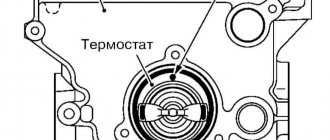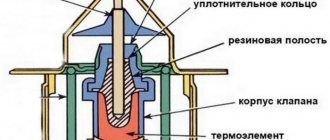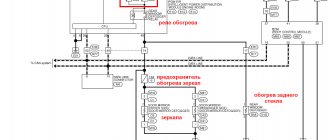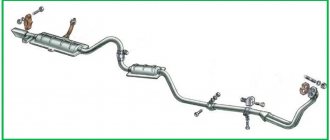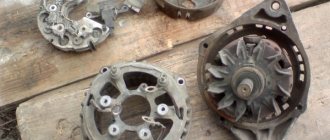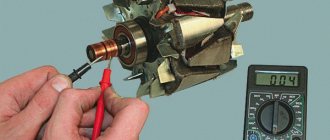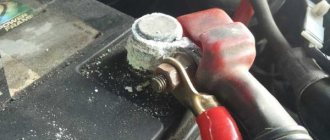Hi all! When the engine is running, it will definitely heat up. The colder the internal combustion engine, the more fuel it will need to consume. But the engine should not be allowed to overheat, since this is fraught with serious consequences. An important element in the power unit temperature control system is the thermostat. It may fail. Therefore, it would be logical to talk about how to check the operation of the thermostat and determine the malfunction of the unit.
Every motorist should know this, since such trouble can await you at any turn.
Previously, when talking about the reasons for engine overheating, one of the key points was the thermostat.
Today I’ll tell you in more detail about its functions, operating features, and also directly discuss the issue of self-checking without removing it.
What is it and how does it work
As you understand, the thermostat is a component of the cooling system of a car engine.
In short, the task of this element is to open and close the path for the movement of fluid that flows through a small or large circle.
The operation of the device is based on a physical phenomenon. Namely, on the expansion of the liquid when it is heated. The thermostat has a rather simple device, although in fact it is a sensor and an actuator in one bottle. It consists of a cylinder which is filled with a waxy liquid, powdered copper, aluminum and graphite. There is also a rod located inside the cylinder and a pair of spring-loaded valves. One valve is for the main (large) one, and the second is for the small circle of circulation of the cooling liquid.
During operation, this element is constantly exposed to the liquid that washes it. Heat is transferred to the contents of the cylinder.
When heating occurs, the wax in the cylinder expands, the rod is squeezed out along with the valve, marking the small circle. Thus, the small circulation circle is blocked, and the liquid begins to pass through the engine radiator, and not just through the stove radiator.
Thermostat operation
Principle diagram of a thermostat.
When starting the car engine for the first time, the temperature at the center of the thermostat is the same as for the coolant, and in order to speed up the engine warm-up time, the thermostat is automatically circulated with a small amount of circulation (cylinder head, which cools the block and both grіvach). At the same operating temperature, the thermostat valve regulates the correct supply of coolant from the main system radiator to the engine. And as the temperature drops, the valve reacts with a greater amount of cooling water, which bypasses the radiator.
This scheme of thermostat operation makes it possible to maintain the required operating temperatures at the same level, ensure good temperature characteristics of the cabin heater, and thereby reduce the toxicity of processed gases with an immediate resource saving. lshennyam machine engine.
The design of the thermostat has a sealed thermo-sensitive element, filled with wax. Every time the temperature of the wax is changed, this will force the thermostatic operating valve to open and close strictly according to the current temperature readings.
How can a motorist understand that these signs of car malfunction indicate the need to look for their causes first in the thermostat? Overheating of the engine or insufficient heating, uncomfortable interior temperature in the cold season, markedly decreased display No car dynamics, as well as fuel movement are the first signs. Before you even think about repairing or replacing the thermostat, you must understand that the thermostat is just one of the many elements of the cooling system that may or may not have been worn out before the vehicle malfunctioned.
To be sure that the reason for the breakdown of the refrigeration system lies in the thermostat, it is necessary to check the temperature sensor of the refrigeration unit, the temperature sensor of the refrigeration unit itself and its indicator (signal lamp) for correctness.
Where is it located
There are many options for what will happen if the thermostat is constantly open on a large or small circle. This will lead to overheating, antifreeze may be released from the expansion tank, the normal pressure in the cooling system will change, and more.
This unit cannot be allowed to malfunction. It is used on all machines:
- on Kalina;
- on Priora;
- VAZ 2114;
- VAZ Classic;
- Ford Focus;
- VAZ 2110;
- Chevrolet Aveo;
- Gazelle Next;
- VAZ 2107;
- Lada Granta;
- Renault Logan, etc.
To check the serviceability of this element on a car, as well as to detect signs of a dying thermostat, you need to at least roughly understand where it is located.
I can't say it's difficult to do.
It is objectively correct to immediately look at the instruction manual. In the section where the cooling system is described, the location of the required element must be indicated.
At the same time, there is a fairly universal search method that is relevant for almost all domestic cars and many foreign cars.
To find a thermostat you need to do the following:
- open the hood;
- find the thickest pipe;
- this will be the radiator hose;
- it goes from the radiator to the engine;
- the second end of this pipe is connected to the thermostat;
- get to the second end;
- determine the location of the thermostat housing;
- start removing it.
Although I still advise you to first look at the manual, and only then start searching, dismantling and repair work.
Thermostat operating principle
The main component of the thermostat is a mechanical valve: it is activated by a fairly simple and correct mechanism. The sealed housing contains a heat-sensitive unnatural wax, which when melted increases in quantity and compresses the rubber chamber, pushing out the chrome-plated iron rod, which causes the valves to act. This is the principle of operation of the thermostat.
This is how a thermostat works
If the integrity of this mechanism is compromised, wax leaks out due to the use of low-quality antifreeze (antifreeze) or corrosion and the friction force of the moving rod increases. The thermostat begins to function incorrectly, slowly and inexorably turning the driver’s life into hell.
What fines can a driver receive for installing a tow bar and trunk?
When starting a cold internal combustion engine, a small circle operates, which helps to warm up the engine and the interior heater faster. Having reached a certain temperature, the sensor is triggered and the system switches to a large circle, transferring engine heat to the internal combustion engine radiator. This prevents the motor from overheating. If the system jams and circulates fluid in a small circle, the engine will inevitably overheat and a number of other ensuing consequences will occur. That is, such situations cannot be allowed to arise.
If the thermostat fails, two main situations may occur.
In the first case, the thermostat switches the cooling system so that a large circulation circle is closed. As a result, the engine gets hot and the gauges on the dashboard go off scale. The motor may jam and related systems and components may fail.
The second situation is somewhat different. Here the thermostat is already stuck in the open position.
In this position, the coolant will constantly flow through a large circuit, affecting the radiator. If it is warm outside, this will not cause any significant problems for the car or the driver himself. So this is less of a reason to panic. But in winter, you will quickly notice that the thermostat is faulty. In cold weather, a power unit with a faulty coolant sensor will slowly warm up, fuel consumption will increase, the heater will not function properly, and the cabin will feel cold.
If you notice that the engine is overheating, or the interior is cold and the heater is not working, this largely indicates problems with an element such as the thermostat.
Thermostat device
The thermostat is a valve
, placed in a housing from time to time, regulates the flow of coolant in
your car's
. In terms of design features, it is not uncommon for thermostats to be designed as either framed or open-framed.
Housing thermostat with two terminals
1. Housing thermostat
As can be seen in the figure, one of the types of thermostats is a device enclosed in a housing and, in most cases, having at least several terminals. The exception is thermostats with a housing device, which form complex 2-level circuits. Thermostat housings are made of plastic, brass or aluminum.
Two terminals located next to each other are in most cases called a “small circuit”. It prevents coolant from entering the radiator, allowing it to circulate into the radiator and heater motor. This makes it likely that the engine will rapidly warm up to the desired (operating) temperature - the point at which the thermostat opens completely. On domestically produced cars, the temperature at which the thermostat is fully opened is often 80-85 degrees.
In most cases, with case thermostats, manual adjustment of the opening and closing temperature is not feasible, but experienced auto repair shops will be able to provide such a service.
2. Frameless thermostat
Simple methods for checking the device
The thermostat contains valves that can open the path of liquid through the radiator, while simultaneously blocking the direct bypass back into the cooling jacket of the block. When the thermal regime has established itself within normal limits, the valves direct most of the antifreeze to the radiator, all processes are stationary, and the liquid temperature is approximately equal at all points. Checking the operation of the thermostat is always based on temperature measurements in different places of the cooling system. It can be done approximately without removing the regulator from the machine, or more accurately after removal.
Condition monitoring without dismantling parts
The process of removing the thermostat itself is usually simple, but it is burdened with procedures for draining the liquid, and then ensuring tightness, filling the system and removing air pockets. Fortunately, in most cases, checking the device directly on the motor will be quite reliable:
- First, you need to find out according to what scheme the thermostat is installed on a particular car, that is, in what order the liquid circulates in the large and small circles. This determines which hose temperature needs to be controlled.
- Having decided on the hose, you can start the engine, and as it warms up, use your hand or a special non-contact device (pyrometer) to measure the temperature of the liquid entering the radiator.
- When the thermostat is operating in a small circle, the radiator supply hose should remain cold, this means that the corresponding valve is working properly.
- As the temperature approaches the operating zone on the dashboard indicator, the hose should begin to warm up and then become as hot as the engine. This will indicate that the thermostat is working properly and both of its valves are operating correctly.
It is almost always possible to check the serviceability of the thermostat without removing it with sufficient reliability. The main rule should be to change it for a new one at the slightest suspicion. Engine health is more important.
Checking the removed thermostat
Sometimes a more precise visual inspection is still required. To find out, for example, whether a working thermostat was purchased without installing it on the car, or to verify the correctness of the declared thresholds for the operation of a part.
The most reliable way to check the functionality of the thermostat is after removing it from the car
To do this, place the thermostat in a vessel with water and place it on the tile. The water is heated and the temperature is controlled with a suitable thermometer. The thermostat usually indicates the temperatures for the start of opening and the complete switching of flow to a large circuit. This can be clearly seen by observing the movement of valves, heating water to a boil and recording the thermometer readings. Performance will be confirmed if the actual threshold values coincide with the declared ones.
How to check a thermostat with a multimeter
Special mention should be made of the so-called electronic thermostats. There are no special electronics, they just have an additional heating element built into them for more precise operation. This allows you to force the opening of the radiator under intense loads, as well as solve the problem of initial opening when the engine has already warmed up and there is not enough heat supplied to the thermostat to operate quickly. In these cases, the engine management system supplies voltage to the heater, which accelerates the thermostat.
To check the heater, just switch the multimeter to ohmmeter mode and measure the resistance between the contacts of the heater connector. Typically it should be between 10-20 ohms. If the connector is four-pin, then there is also a temperature sensor in the thermostat housing; they have different resistances, which can be found out from the specification of a particular device and checked with the same multimeter.
Car thermostats are not so complex that anyone with a minimum of curiosity could not cope with checking them. And this should be done not only when signs of a malfunction appear. For example, experience shows that these devices do not like scheduled replacements of antifreeze, air locks in the system, and simple aging of the coolant. In all these cases, it makes sense to carry out the simple checks described above.
Adviсe
The thermostat is a necessary part in any car. The choice of a new mechanism and proper operation are very important.
- When choosing a thermostat, you need to pay attention to the manufacturer. It is worth buying devices only from trusted companies.
- The body of the device must be made of brass or copper. Only these metals are heated evenly with antifreeze.
- After the vehicle has been idle for a long time, scale deposits or oxidation may occur in the element. It is necessary to disassemble and clean the locking mechanism.
- It is prohibited to dilute antifreeze with water in any, even small proportions.
- It is prohibited to operate the cooling system with ordinary, even distilled water. Water forms scale and it is very difficult to get rid of it.
- Also, do not operate the car with an empty thermostat. The absence of a valve will affect the operation of the engine, as it will be operated at insufficient temperatures.
Any problems with the thermostat must be corrected in a timely manner.
Necessary tools
- New thermostat.
- Open-end wrenches for 13 and 12.
- Phillips screwdriver (medium size).
- An empty container for draining the coolant (it is better if it is a basin with a capacity of at least 5 liters; it will fit under the car without any problems).
- Sealant.
- Using a 13 key, unscrew the air filter.
- Unscrew 2 bolts and 1 nut on the radiator. Under one of the bolts there is a hole through which the coolant is drained into a container placed in advance under the radiator. A drain bolt on the radiator for draining antifreeze.
- The connector located on the recirculation valve filter housing is removed. Then the valve itself is removed and carefully moved to the side along with all the tubes located next to it. The connector from the air flow sensor is also removed, the clamp on it is loosened, after which the air supply hose is removed. All hoses have been removed from the recirculation filter housing, the thermostat is ready for removal.
- After these operations, the filter is easily removed and access to the thermostat is opened.
- Use a 12 wrench to unscrew the nut on the top of the thermostat (there is only one there). After this, the ground wire is removed and the stud and the lower nut on the device are unscrewed with a 13mm wrench.
- After this, the thermostat is removed from the socket (this is done by slightly shaking the device, and if this does not help, the thermostat is pryed off with a screwdriver). The thermostat is carefully removed from the socket.
- Before installing a new thermostat, the socket is thoroughly wiped off from drops of coolant and other contaminants, after which a thin layer of sealant is applied (the sealant must be allowed to dry for at least 5 minutes before installing the device).
- The new thermostat is installed in its original place, after which all components of the vehicle’s cooling system are reassembled.
As you can see from this article, changing the thermostat is a task that even a novice car enthusiast can do. The main thing to remember when deciding to replace this device is that you cannot save money on it, since repairing engine damage caused by a faulty thermostat will cost the car owner much more.
Without removing it from the car: how to check the thermostat for serviceability using the engine radiator pipes
The main heat exchanger is connected to the engine cooling system by two hoses: inlet and outlet. The direct function of the thermostat is to connect/disconnect the heat exchange device by opening/closing one of the tubes at a temperature of 82-87°C. Which one is decided by the engine manufacturer.
Which hose should I touch?
Before you check the thermostat without removing it from the engine, you need to find out where it is installed: before the radiator or after it. This affects which pipe will be used to assess the regulator’s performance:
- Upper - in systems with a thermal switch located in front of the heat exchanger (for example, Lada Granta).
- Lower - in designs with a thermostat after the radiator (for example, VAZ 2110, Hyundai Solaris, Peugeot 308).
Norm and deviations
The diagnosis is made by the temperature of the hose. There are two methods for assessing it: approximate (by touch of the hand) and accurate (with a pyrometer). It is necessary to start diagnostics immediately after a cold start of the engine, examining the degree of heating of the upper or lower tube (depending on the thermostat layout):
- The tested hose was cold for some time, and the rest were hot, then became warm. If a pyrometer is used, at this moment the temperature of the pipe rises sharply to the point at which the thermostat opens. The thermostat switched the flow to a large circle. OK.
- The blocked tube immediately began to slowly warm up. The thermal switch is constantly open, and antifreeze circulates through the radiator when the engine is cold. Defective - stuck in an open, intermediate position or does not close completely.
- The hose being examined is constantly cold; according to the sensor on the dashboard, the temperature of the power unit has reached operating temperature. The thermostat is stuck in the closed position, the coolant constantly moves in a small circle. Defective.
Indicators of thermostat malfunction
Clear indicators of a thermostat malfunction are:
- prolonged warming up of the engine to operating temperature, and its rapid overheating;
- the engine temperature arrow drops at speeds below normal and rises when the car stops;
- the lower pipe is warm after a few minutes of warming up the engine: this indicates that the thermostat is open all the time;
- The thermostat is stuck in the closed position, the engine is boiling, but the lower pipe remains cold, even when the engine is warm
Required reading:
- How to determine the real mileage of a car
- European protocol for road accidents in 2015
- How is a traffic police report on an administrative offense required to be drawn up and filled out?
- What to do if the Check Engine light comes on?
- What should you do when a traffic violation report is drawn up against you?
- Car antennas for TV
- Liquid rubber for a car: its pros, cons, use
When to change: signs of thermal switch failure
A cold oven is already a reason to check the thermostat through the radiator pipes to find out whether it switches circulation from a small to a large circle and back or not. This is in winter, and in spring or autumn it is necessary to feel the hoses during a prolonged engine warm-up cycle. The wedge in a different position is especially noticeable in the summer, when the engine overheats as a result of the radiator being turned off.
Abstract symptoms can indicate the nature of the disease that has befallen the thermostat:
Stuck in open position (coolant constantly circulates through radiator)
In cold weather, the engine does not heat up well, and at extreme city speeds the coolant temperature drops. Let's say it's -15°C outside, the coolant at idle has warmed up to 70°C, we're driving on a multi-lane road, moving at a speed of 60 km/h, and the temperature gauge needle is either standing still or going down.
Fuel consumption increases noticeably (+ 1-2 liters per 100 km). The wedge is in the closed position (antifreeze moves along the jacket and heater radiator, bypassing the main heat exchanger). There will be no cooling and overheating is inevitable in summer. The fact is clearly clarified by the thermometer needle running upward when the cooling fan is on. Additionally, the “brains” indicate a problem in the form of an illuminated Check Engine icon. Final stop at an intermediate position. Prolonged heating + overheating in hot weather. Slight increase in appetite (within 1 l/100 km).
It is impossible to close a large circle tightly, while the rod moves and the full opening occurs. There is no wedge. This is prevented by deposits accumulated as a result of untimely change of antifreeze, mixing coolant of different classes (for example, on a Hyundai Solaris, antifreeze can only be mixed with G11), and the use of cheap or counterfeit fluids. The fact can be revealed in warm weather only through tubes. In winter, pollution will be indicated by a reluctant rise in temperature from 70°C to 90-95°C when driving on the highway, but in the city there will be no problems with warming up. Seeing such a picture, those who like to cover the radiator grille with cardboard often persuade the owner to insulate the front end. This is definitely useful in cold weather.
What engines does the VAZ 2110 come with?
The VAZ-2110 car has been produced since 1996. At the same time, the power part gradually underwent changes:
- 21100 - base model produced in 1996-2000. The car was equipped with an engine with 8 valves and a volume of 1.5 liters (power 69 hp);
- 21101 is a model produced since 2004. Engine - injection, 1.6 liters, 8 valves;
- 21102 - 8-valve engine, 1.5 liters, injector;
- 21103 - 16-valve unit, 1.5 liters, injector.
- 21103 M - 16-valve engine, 1.5 liters, injector (produced since 2002);
- 21104 - 16-valve engine, 1.6 liters, injector;
- 21104M -16-valve engine, 1.6 liters, produced since 2004;
- 21106 GTI - 16-valve engine, 2.0 liters, 150 hp;
- 2110 “Premier” - 16-valve power unit, volume -1.5 liters;
- 2110 “Consul” - limousine, volume - 1.5 liters;
- 2110-91 - rotary piston engine, 1.3 liters.
Thermal service thermostat
The manual thermostat is installed directly on the radiator and significantly saves heat.
Signs of thermostat malfunction often include accumulated sediment in the refrigeration system. Scale appears on the heat-sensitive element after it has lost its rustiness, and it begins to react incorrectly to temperature changes in the cooling medium, or even stops responding altogether.
Possible reasons for this breakdown: leakage of water from the cooling unit, untimely replacement of the cooling unit, possible jamming of the thermostat in the open position, in which the cooling unit will constantly circulate along the large circuit. The other reason is that the engine has to warm up for a long time to the temperature of the engine, which is often simply beyond its reach. And when the thermostat is stuck in the closed position, the circulation will only be small, which will inevitably lead to overheating of the engine.
